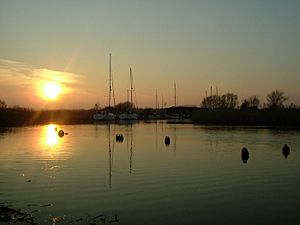River Frome, Dorset facts for kids
Quick facts for kids River Frome |
|
|---|---|

River Frome near Dorchester
|
|
|
Location within Dorset
|
|
| Country | United Kingdom |
| County | Dorset |
| Physical characteristics | |
| Main source | Evershot, Dorset 175 m (574 ft) 50°50′15″N 2°36′02″W / 50.83750°N 2.60056°W |
| River mouth | Poole, Dorset 50°41′45″N 1°59′19″W / 50.69583°N 1.98861°W |
| Discharge (location 2) |
|
The River Frome is a river located in Dorset, a county in the south of England. It stretches about 30 miles (48 km) long. This makes it the most important chalkstream in southwest England. A chalkstream is a river that gets its water from underground chalk rocks.
The river is also "navigable" from Poole Harbour up to the town of Wareham. This means boats can travel on this part of the river.
Contents
Where the River Frome Flows
The River Frome begins in the Dorset Downs near a village called Evershot. This is where the river "rises" or starts its journey.
From Evershot, the river flows through several towns and villages. These include Maiden Newton, Dorchester, West Stafford, and Woodsford.
When it reaches Wareham, the River Frome joins another river, the River Piddle. Both rivers then flow into Poole Harbour through a path called the Wareham Channel.
River Frome's Catchment Area
The area of land that collects rainwater and sends it into the River Frome is called its "catchment area." This area is about 181 square miles (469 km²). This is roughly one-sixth of the entire county of Dorset.
East of Dorchester, the river flows over different types of ground like sand, clay, and gravel. These layers are on top of chalk. Because the valley here is not very steep, the Frome has left a lot of mud and dirt over time. This has created a wide, flat area known as a floodplain.
Long ago, this floodplain had many marshes (wet, muddy areas). These marshes gave the name to the Durotriges, an ancient Celtic tribe who lived in Dorset. Their name meant "water dwellers," showing how connected they were to the river.
At its end, where the river meets the sea, it forms a wide, shallow "estuary" called Poole Harbour. An estuary is where the river's fresh water mixes with the salty sea water. This type of estuary is also known as a "ria."
History of the River Frome
The River Frome has played an important role in human history for a very long time.
Roman Aqueduct
Around the end of the 1st century AD, the Romans built a special water channel called an aqueduct. This aqueduct was about 12 miles (19 km) long. Its purpose was to bring water to public fountains and baths in their new town, Durnovaria (which is now Dorchester).
The aqueduct was an open channel cut into the chalk ground. It took water from the Frome upstream near Notton, between Maiden Newton and Frampton. It followed the natural shape of the valley side. Over its entire length, the aqueduct only dropped about 25 feet (7.6 m) in height. This was much less than the river itself.
It's believed that the aqueduct could deliver about 8 million gallons (30 million litres) of water to Durnovaria every day. You can still see some parts of the aqueduct today near Bradford Peverell and on the Dorchester bypass.
Viking Raids and Trade
The Danes, also known as Vikings, often sailed up the River Frome to attack towns. To protect the town of Wareham from these attacks, its walls were built in 876. It's thought that Alfred the Great might have ordered these walls to be built.
Until the late 1800s, the river was very important for trade. It was used to export a special type of clay called Purbeck Ball Clay from the Isle of Purbeck. At first, the clay was brought to the wharves (docks) in Wareham by pack horses from the clay pits.
Around 1830, the Furzebrook Railway was built. This railway connected the clay pits directly to a wharf at Ridge. Later, trains and then roads took over this job, and the river became less important for transporting clay.
River Frome's Wildlife
The River Frome is home to many different kinds of wildlife. However, the number of salmon swimming up the river has dropped a lot in recent years.
In 1988, more than 4,000 salmon swam up the river. By 2004, this number had fallen to only 750 fish. The Game & Wildlife Conservation Trust is studying this problem. They have a research center at East Stoke.
Their goal is to understand why the number of Atlantic Salmon is decreasing. They also want to find ways to help the salmon population grow again.
Images for kids
See also
 In Spanish: Río Frome (Dorset) para niños
In Spanish: Río Frome (Dorset) para niños




